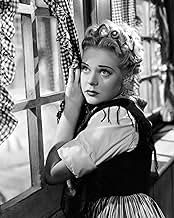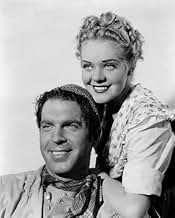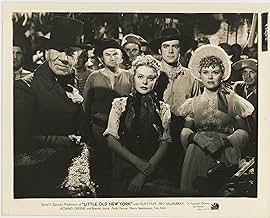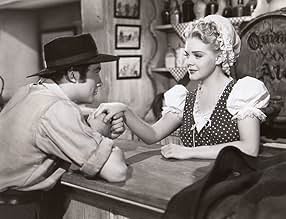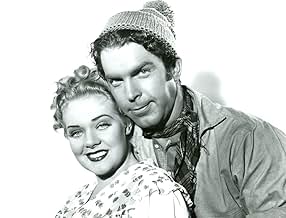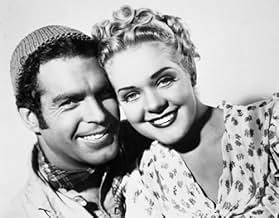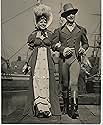NOTE IMDb
6,4/10
276
MA NOTE
Ajouter une intrigue dans votre langueSteamboat inventor Robert Fulton shows up in New York in 1807. Tavern keeper Pat O'Day believes in him, but her boyfriend doesn't. All seems lost after sailors, afraid of losing their jobs, ... Tout lireSteamboat inventor Robert Fulton shows up in New York in 1807. Tavern keeper Pat O'Day believes in him, but her boyfriend doesn't. All seems lost after sailors, afraid of losing their jobs, burn his boat.Steamboat inventor Robert Fulton shows up in New York in 1807. Tavern keeper Pat O'Day believes in him, but her boyfriend doesn't. All seems lost after sailors, afraid of losing their jobs, burn his boat.
- Réalisation
- Scénario
- Casting principal
Clarence Wilson
- Willie Stout
- (as Clarence Hummel Wilson)
Theodore von Eltz
- Washington Irving
- (as Theodore Von Eltz)
Oscar 'Dutch' Hendrian
- Blackie
- (as O.G. Hendrian)
Avis à la une
This film sports winning performances (Alice Faye is delightful and very accomplished as a light comic actress), plenty of well-played comedy and well-staged action, a fine Alfred Newman score. But what really impressed and intrigued me were some elaborately staged outdoor scenes which appeared to be at least partially shot on a real 18th century seaport, not just the back lot. Either Fox spent a whole lot of money constructing a very large and realistic looking seaport set, or some of this was shot on location at some historic recreation site, or the art director was a genius in making the back lot look a lot bigger than it was. Interesting to see what a muscular hunk Fred MacMurray was, very different than his image in later years.
This is an incredibly fictionalized account of the work of Robert Fulton to make the first American steamship. Alice Faye, Fred MacMurray and Ward Bond are there...even though they really were inventions of the playwright to first came up with this story. As a history lesson, it comes up lacking! What follows is sort of a comic book version of history--the sort of thing that Hollywood often did in their highly fictionalize 'true stories'.
So is this any good? Well, it looks nice. Twentieth Century-Fox made lovely looking films and the music and glitz are all present in this expensive production. It's also mildly entertaining...but slight. No great drama or comedy here...just another highly fictionalized film along the same lines as "In Old Chicago" and nothing more.
So is this any good? Well, it looks nice. Twentieth Century-Fox made lovely looking films and the music and glitz are all present in this expensive production. It's also mildly entertaining...but slight. No great drama or comedy here...just another highly fictionalized film along the same lines as "In Old Chicago" and nothing more.
Though it probably has zip to do with the actual story of Robert Fulton and the invention and manufacture of the first steam engine this is a very pleasant little drama with light overtones. That's mainly due to the cast, all very competent performers who have a nice chemistry together.
Alice Faye, not singing this time, is full of brassy snap as the most virtuous waterfront innkeeper who never existed who longs to leave the docks behind and become a lady. She's matched by Fred MacMurray full of cheery bonhomie as a shipbuilder, the now amusingly named Charley Brownne, who has a yen for Alice. Richard Greene is a bit of a stick as Fulton but he and Brenda Joyce make an attractive pair. And Andy Devine is along to add his squeaky voiced charm as a buddy of the lead pair.
The title, an obvious attempt by Fox to conjure up thoughts of Alice's big hit of a few years before, In Old Chicago, has very little to do with the picture. You hardly see any outdoor shots of the city but the interior sets are handsomely mounted if unimaginatively lit as you'd expect for a Fox feature for their top star.
If you're looking for a history lesson about the progress of navigation during the country's early years you won't find it here but if a enjoyable diversion for about an hour and a half is what you seek this will fill the bill. Nothing spectacular but a nice hidden gem for fans of the stars.
Alice Faye, not singing this time, is full of brassy snap as the most virtuous waterfront innkeeper who never existed who longs to leave the docks behind and become a lady. She's matched by Fred MacMurray full of cheery bonhomie as a shipbuilder, the now amusingly named Charley Brownne, who has a yen for Alice. Richard Greene is a bit of a stick as Fulton but he and Brenda Joyce make an attractive pair. And Andy Devine is along to add his squeaky voiced charm as a buddy of the lead pair.
The title, an obvious attempt by Fox to conjure up thoughts of Alice's big hit of a few years before, In Old Chicago, has very little to do with the picture. You hardly see any outdoor shots of the city but the interior sets are handsomely mounted if unimaginatively lit as you'd expect for a Fox feature for their top star.
If you're looking for a history lesson about the progress of navigation during the country's early years you won't find it here but if a enjoyable diversion for about an hour and a half is what you seek this will fill the bill. Nothing spectacular but a nice hidden gem for fans of the stars.
Robert Fulton after trying and failing to develop a ship powered by a steam engine is having trouble getting some new backing. A prototype vessel blew up on the River Seine as he was trying to impress Napoleon Bonaparte with steam's potential. Now he's back in Little Old New York trying to sell the idea to the movers and shakers of his day.
Richard Greene plays the idealistic and gentlemanly Fulton. But the only two converts he makes are his landlady, tavern owner Alice Faye and Fred MacMurray, who works for Ward Bond at a shipyard. But after Fulton beats bully boy Bond in a fight, MacMurray loses his job. But Fred starts his own shipyard and his first client will be Fulton if he can raise the money.
Little Old New York had the story of Robert Fulton grafted on to a play by Rida Johnson Young of the same name that was the basis for the film. There's no mention that in real life Fulton was as handy with his dukes as he is in this film. It is true he married the niece of Chancellor Robert Livingston played by Brenda Joyce and Livingston did finally sell some of his friends like Nicholas Roosevelt, John Jacob Astor, and Washington Irving to finally back Fulton's steamboat.
Livingston is played by one of my favorite character actors Henry Stephenson who always brings a touch of old world class to all his roles. Livingston's title of Chancellor stems from the fact the chief judicial officer of New York had that title, a carryover from colonial days. Among other things Livingston did was swear in George Washington to his first term as president. There was no Supreme Court yet because Washington hadn't appointed anyone yet.
Little Old New York probably was seen by Darryl Zanuck as a fitting sequel to In Old Chicago which was Alice Faye's first period costume film. The parts that Fred MacMurray and Richard Greene have are those that would normally have been played by Tyrone Power and Don Ameche. In fact I could see both of those guys playing either of the MacMurray or Greene parts.
If Little Old New York is not the real story of Robert Fulton it certainly is a nice bit of entertainment served up by a fine cast at the direction of Henry King.
Richard Greene plays the idealistic and gentlemanly Fulton. But the only two converts he makes are his landlady, tavern owner Alice Faye and Fred MacMurray, who works for Ward Bond at a shipyard. But after Fulton beats bully boy Bond in a fight, MacMurray loses his job. But Fred starts his own shipyard and his first client will be Fulton if he can raise the money.
Little Old New York had the story of Robert Fulton grafted on to a play by Rida Johnson Young of the same name that was the basis for the film. There's no mention that in real life Fulton was as handy with his dukes as he is in this film. It is true he married the niece of Chancellor Robert Livingston played by Brenda Joyce and Livingston did finally sell some of his friends like Nicholas Roosevelt, John Jacob Astor, and Washington Irving to finally back Fulton's steamboat.
Livingston is played by one of my favorite character actors Henry Stephenson who always brings a touch of old world class to all his roles. Livingston's title of Chancellor stems from the fact the chief judicial officer of New York had that title, a carryover from colonial days. Among other things Livingston did was swear in George Washington to his first term as president. There was no Supreme Court yet because Washington hadn't appointed anyone yet.
Little Old New York probably was seen by Darryl Zanuck as a fitting sequel to In Old Chicago which was Alice Faye's first period costume film. The parts that Fred MacMurray and Richard Greene have are those that would normally have been played by Tyrone Power and Don Ameche. In fact I could see both of those guys playing either of the MacMurray or Greene parts.
If Little Old New York is not the real story of Robert Fulton it certainly is a nice bit of entertainment served up by a fine cast at the direction of Henry King.
"Little Old New York" is a fictional story about Robert Fulton's invention of the first successful steamboat. It is based on a 1920 Broadway play by Rida Young of the same title that ran for 308 performances. Young was a playwright who became best known for her lyrics to Victor Herbert's operetta, "Naughty Marietta."
Fulton had been living in Europe for some 20 years where he first made a living as a painter and then began working on inventions, sometimes with others. Back in the States, Fulton set out to find backing to build the first steamboat to navigate rivers. Henry Stephenson plays Robert Livingston, a former U.S. ambassador whom Fulton had met and befriended in England. Livingston helped raise the funds for Fulton's steamboat.
Richard Green plays Robert Fulton, and while the story is about his invention, it revolves mostly around another couple. Much, if not most of this is fictional, of course. Alice Faye plays Pat O'Day, a wharf front tavern owner who first is smitten by Fulton, and then helps round up support and finances for him. Her cohort in this adventure is Charles Brownne, played by Fred MacMurray. He's been Pat's beau all along.
This is a light comedy and drama about Fulton's invention. It does have some historical value, but mostly in its pictorial presentation of the docks and shipbuilding of 18th and 19th centuries, The Fox studio did a superb job in replicating the shipbuilding works of New England of the day. And in portraying the craft of shipbuilding at the time.
Fulton had been living in Europe for some 20 years where he first made a living as a painter and then began working on inventions, sometimes with others. Back in the States, Fulton set out to find backing to build the first steamboat to navigate rivers. Henry Stephenson plays Robert Livingston, a former U.S. ambassador whom Fulton had met and befriended in England. Livingston helped raise the funds for Fulton's steamboat.
Richard Green plays Robert Fulton, and while the story is about his invention, it revolves mostly around another couple. Much, if not most of this is fictional, of course. Alice Faye plays Pat O'Day, a wharf front tavern owner who first is smitten by Fulton, and then helps round up support and finances for him. Her cohort in this adventure is Charles Brownne, played by Fred MacMurray. He's been Pat's beau all along.
This is a light comedy and drama about Fulton's invention. It does have some historical value, but mostly in its pictorial presentation of the docks and shipbuilding of 18th and 19th centuries, The Fox studio did a superb job in replicating the shipbuilding works of New England of the day. And in portraying the craft of shipbuilding at the time.
Le saviez-vous
- AnecdotesThe play opened on Broadway in New York City, New York, USA on 8 September 1920 and closed in June 1921 after 303 performances. The opening night cast included Genevieve Tobin as Pat O'Day, Douglas Wood, as Cornelius Vanderbuilt and Donald Meek.
- GaffesThe hairstyles of the women are from the time the film was made, not from the early 1800s.
- ConnexionsReferenced in Star Dust (1940)
- Bandes originalesWho Is the Beau of the Belle Of New York
(1940) (uncredited)
Music and Lyrics by Mack Gordon
Performed by Tyler Brooke and joined by Alice Faye and other dancing patrons of Krausmeyer's Pavillion
Meilleurs choix
Connectez-vous pour évaluer et suivre la liste de favoris afin de recevoir des recommandations personnalisées
Détails
- Date de sortie
- Pays d’origine
- Langue
- Aussi connu sous le nom de
- Little Old New York
- Lieux de tournage
- Société de production
- Voir plus de crédits d'entreprise sur IMDbPro
- Durée1 heure 40 minutes
- Couleur
- Rapport de forme
- 1.37 : 1
Contribuer à cette page
Suggérer une modification ou ajouter du contenu manquant

Lacune principale
By what name was Les révoltés du Clermont (1940) officially released in India in English?
Répondre
